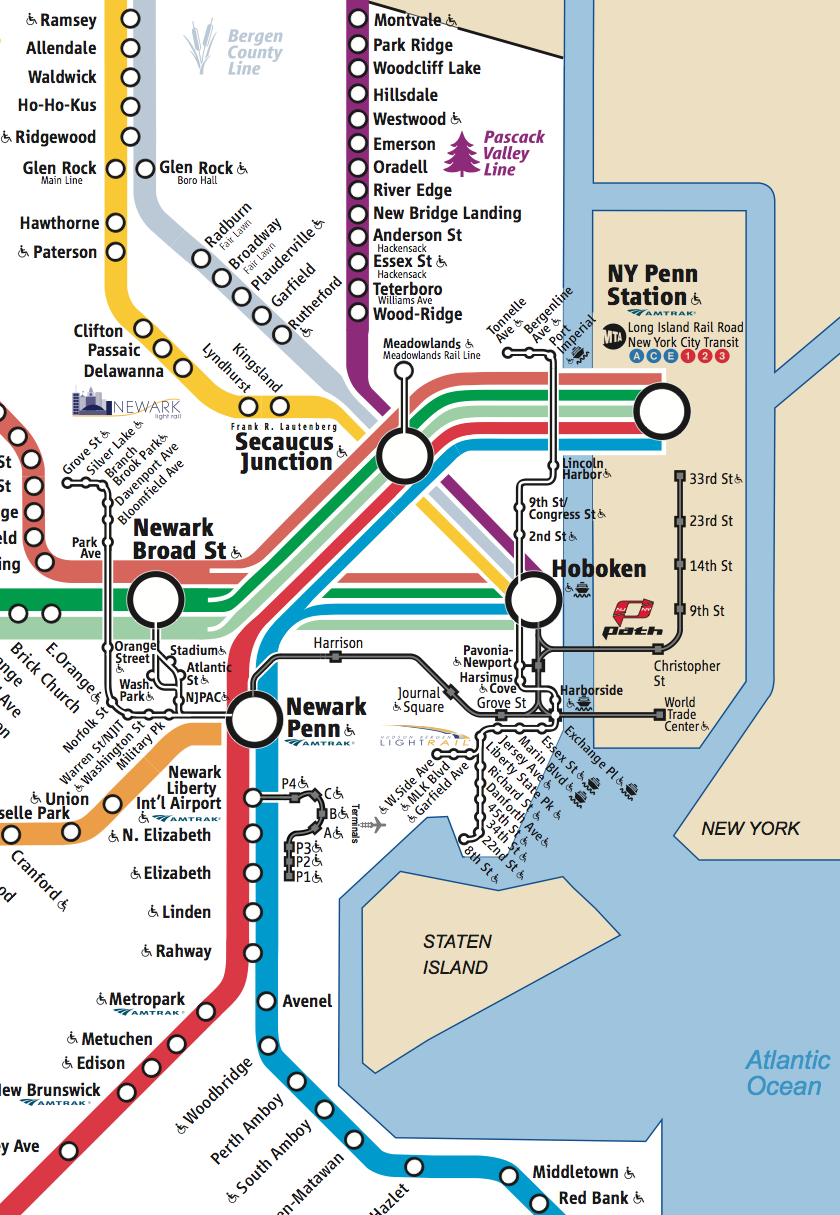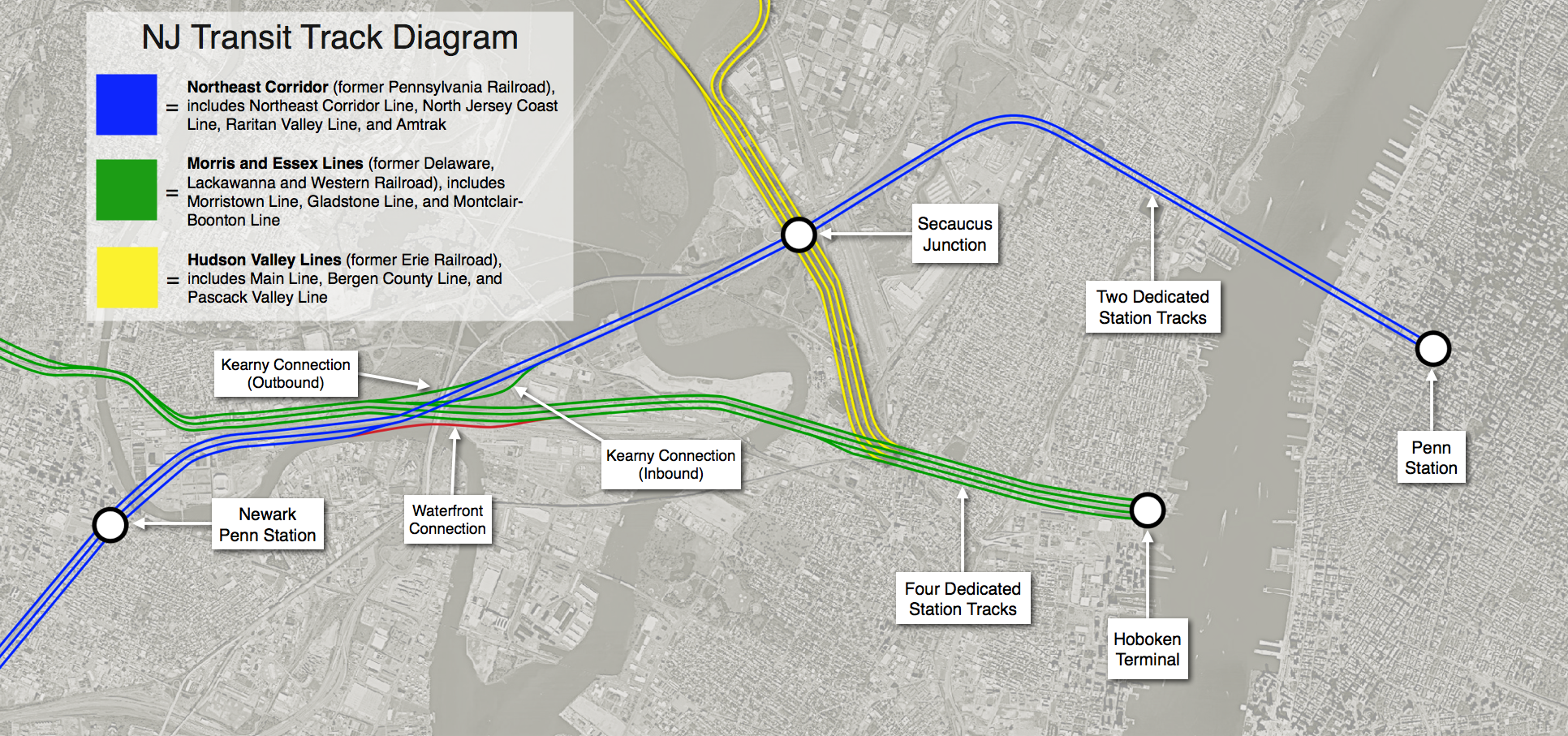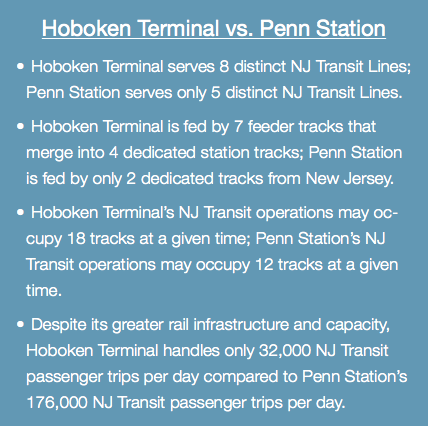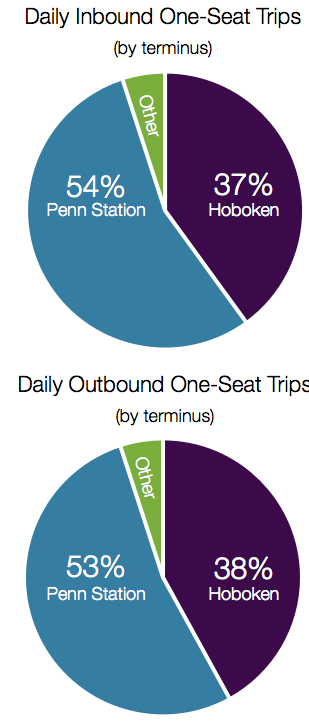Table of Contents
Download Planning for a New Northeast Corridor:

Download The Hudson Terminal Plan:

Download the Trends & Opportunities Report:

The Hudson Terminal Plan
Choosing the Path to the Next Great Transit Hub
Looking only at a map of NJ Transit’s rail lines, it would appear that the center of the New York metropolitan region is located in Hoboken, NJ, where the greatest number of commuter rail lines terminate. Of course, this could not be further from the truth. Hoboken has a population of 50,000 while New York City has a population of over 8 million. Nevertheless, the Hoboken transit infrastructure is built to accommodate a huge city. This is because Hoboken used to accommodate a huge city—New York City.
Before the advent of tunneling technology, all trains from points south and west terminated on the western banks of the Hudson River. Upon arriving at the various rail terminals, travelers would then transfer to ferries to Manhattan. The Delaware, Lackawanna and Western Railroad terminated in Hoboken at the current Beaux-Arts Hoboken Terminal. The Erie Railroad terminated directly below Hoboken Terminal by today’s Newport PATH Station. Lastly, the Pennsylvania Railroad terminated below the Erie Railroad’s station in Jersey City by today’s Exchange Place PATH Station. In 1910, with the completion of the two single-track North River Tunnels and the opening of Penn Station, the Pennsylvania Railroad became the first west-of-the-Hudson regional rail system to travel directly into Manhattan. In the 1950s, the Erie Railroad shifted its operations to Hoboken Terminal, and by 1960, merged with the Delaware, Lackawanna and Western Railroad to form the Erie Lackawanna Railroad. By the mid-1970s, railroads across the nation were struggling and the federal government took two bold actions: 1) consolidating regional railroads including the Pennsylvania Railroad and Erie Lackawanna Railroad into the Conrail System; and 2) creating Amtrak to operate intercity rail systems. In 1983, the commuter rail segments of Conrail were returned to various state agencies, resulting in the formation of the current NJ Transit system in use today.
At the time of NJ Transit’s creation, lines terminating at Penn Station and lines terminating at Hoboken Terminal were completely independent from one another. However, this changed with the completion of the Waterfront Connection in 1991, which provided a single track connector from the Northeast Corridor to the Morris and Essex Lines terminating in Hoboken. In addition, in 1996, NJ Transit completed the dual-track Kearny Connection, which provided trains along the Morris and Essex Lines the option of traveling directly into Penn Station. Finally, in 2003, Secaucus Junction opened to the public, allowing riders along the Hudson Valley Lines to transfer to Northeast Corridor trains bound for Penn Station.
Since the completion of the North River Tunnels in 1910, commuters along today’s NJ Transit lines have, in greater and greater numbers, chose to terminate at Penn Station for obvious reason: passengers terminating in Hoboken require additional travel to arrive in Manhattan. However, despite the increased ridership along Penn Station lines, rail infrastructure in New Jersey still heavily favors travel to Hoboken Terminal. And for the over 400 NJ Transit trains traveling towards New York City, only 54% of them terminate in Penn Station. As noted by the track diagram above, Hoboken-bound trains share seven feeder tracks merging into four dedicated station tracks at the Bergen Tunnel. In contrast, trains heading to Penn Station use only two feeder tracks continuing to the two single-track North River Tunnels. At the same time, 176,000 NJ Transit riders travel through Penn Station every weekday, while only 32,000 NJ Transit riders travel through Hoboken Terminal. This means that NJ Transit trains terminating at Penn Station are limited to half the trackage for five times the daily volume as NJ Transit trains terminating at Hoboken Terminal. This results in overcrowding, not only within trains, but on platforms and at stations throughout the system. Some proposals have suggested doubling the cross-Hudson capacity into Penn Station to four tracks. However, even then, Penn Station would still serve two and a half times more trains per inbound track than Hoboken Terminal.
Considering the cost, the solution is not to increase the supply, but rather to reduce demand for trains traveling to and from Penn Station by increasing demand elsewhere in the system. Thus, it seems natural to do what engineers would have done when tracks were first laid to Hoboken over 100 years ago—extend the four inbound tracks from Hoboken to New York City. Not only would this be a better use of current resources because of the existing rail infrastructure feeding into Hoboken Terminal, but it would also triple cross-Hudson rail capacity (by adding four new tracks) as opposed to merely doubling it (by adding two tracks to Penn Station). In addition, plans attempting to alleviate overcrowding in Penn Station by merely increasing train capacity therein would require a significant increase in NJ Transit service to Penn Station, in turn requiring the purchase of new rolling stock, expansion of existing rail yard capacity, and increase in NJ Transit’s annual operations budget, which already suffers from severe deficits. On the other hand, Hoboken Terminal, despite handling 80% fewer passengers than Penn Station each day, still receives just 30% fewer daily trains, as noted by the charts above. Put another way, Hoboken receives nearly 40% of NJ Transit’s trains for 18% of NJ Transit’s passengers. By simply shifting existing resources, as opposed to using new resources, an extension of the tracks from Hoboken to a new terminal in Manhattan will capitalize on the robust, yet underused, commuter service terminating at Hoboken Terminal.





